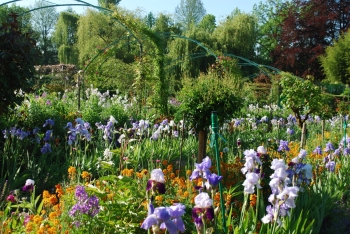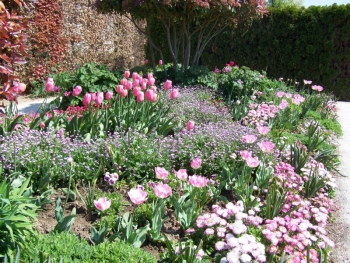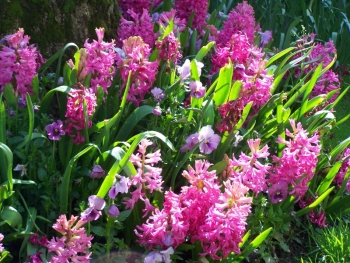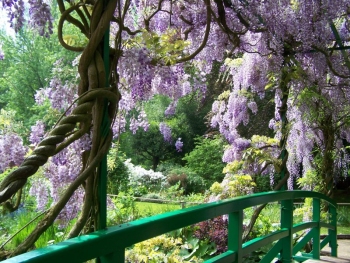January 28, 2011
On April 1st, when Fondation Claude Monet opens again for a new season, it is early Spring.
On the hills of the Seine valley, the pastures are still grey, waiting for a new grass to grow.
But in Monet’s garden, the first flowers display their colors.
The weeping willows open their buds and swing their freshly born leaves over the pond.
On the river side, the small basket willows stretch their orange twigs.
These traditional trees are useful to prevent the banks from slipping into the river, and they are lovely too.
It is still Winter right now, but we are all looking forward to Spring.
Posted in Giverny, Water-Garden No Comments »
June 3, 2010
Monet’s garden at Giverny is so beautiful at the turn of May and June that it has a taste of Paradise.
In this season, spectacular flowers like irises, paeonies, wallflowers and roses bloom all at the same time.
The small walks of the garden disappear, leaving the illusion of a divine meadow adornated by the most exquisite flowers.
Not to speak about the delicate scent floating in the air…
Posted in Giverny, Claude Monet, Monet's flower garden No Comments »
April 16, 2010
Spring at Giverny is like fireworks renewed every two weeks.
Daffodils and hyacinths burst out first, followed by tulips and alliums.
Bright colorful bulbs are everywhere, in the middle of the lawns, in squares, in rows, squattered in flowerbeds…
The gardens of Claude Monet opened two weeks ago, on April 1st. During the winter, benches and fences have been freshly repainted in green, and the spring garden looks repainted too, with the fresh greens of leaves and of grass.
Japanese cherries and crab apple offer their blossoms to the breeze, creating delicate flakes of pink snow.
The air is full of delicious scents and birds songs, and the sun is higher every day.
Posted in Giverny, Monet's flower garden No Comments »
March 2, 2009
This is how the garden of the Museum of Impressionisms Giverny looks like in April.
Small chambers of monochromatic beds are hidden behind tall hedges. Each one has a different atmosphere, creating a surprising effect for visitors who stroll along the central alley.
Tulips are a must in spring, of course. But they need to be planted together with smaller flowers at their feet for a greater impact.
Several varieties are suitable to cover the bare ground. Pansies exist in so many colors that it is possible to create infinite harmonies.
Daisies are also a simple solution. Their pink gives a fresh look to the flower bed.
But if you are as lazy as I am, you will certainly prefer forget-me-nots. They reseed on their own and offer a very tender and poetic cloud of tiny flowers for weeks.
They are generally blue, but can also be found in pink or white. In Monet’s garden they are widely used: blue forget-me-nots with pink tulips, white ones with white tulips or pink with pink tulips for a ton sur ton harmony.
Here in the Museum’s garden they are planted in a wave towered by a bunch of tulips: this way they give rhythm to the border.
Posted in Impressionism Museum No Comments »
February 17, 2009
Aren’t you tired of winter? We all look forward to spring. In Monet’s garden sprouts of flowers are coming out, while the gardeners are busy planting the pansies.
This is the way they will look in early April. Hyacinths will be already in full bloom and full scent, their delicate perfume recognizable steps away. At Giverny they greet the visitors right at the entrance to the garden.
Their pink combines perfectly with the mauve pansies flowering at the same time. All together they make a bunch of spring.
Posted in Monet's flower garden, Flower No Comments »
May 14, 2008
The wisteria is at its peak over the Japanese Bridge in Claude Monet’s garden.
Its flowers look like long grapes. They are a soft tone of lavender and produce a delicious scent which recalls to the scent of jasmine.
It is an incredible feeling to stand on the bridge and be surrounded by the blooming wisteria all around you.
The beautiful effect doesn’t last very long, but Monet had thought of a special jocker. A second later wisteria will follow the lavender one when it is over. The second one is a white wisteria.
Posted in Water-Garden 1 Comment »





